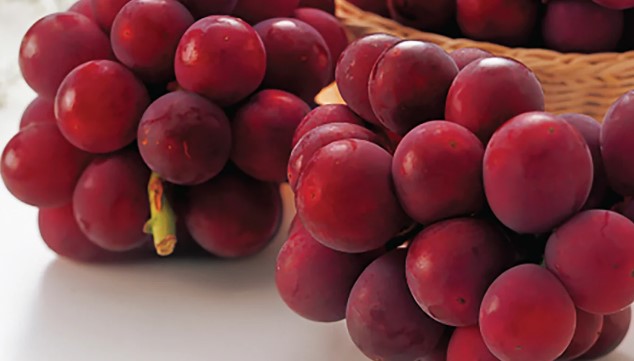Ruby Roman Grapes Introduction: These are a type of table grape that is known for its sweet taste and deep red color. The grapes are large and round, with a thick skin that is easy to peel. They are a popular choice for eating fresh, but they can also be used for making juice, wine, and jams.
Ruby Roman grapes are thought to have originated in Italy and are believed to be a cross between two other grape varieties, the Red Globe and the Black Magic. The grapes are typically harvested in late summer or early fall and can be found in grocery stores and farmers’ markets around this time of year.
Overall, Ruby Roman grapes are a delicious and versatile choice for anyone looking for a sweet and healthy snack. They are packed with nutrients and antioxidants and can be enjoyed in a variety of different ways. Whether you’re eating them fresh, making jam, or using them to make wine, Ruby Roman grapes are sure to be a hit with everyone.
Benefits of Ruby Roman Grapes: One of the main benefits of Ruby Roman grapes is their high sugar content, which makes them a delicious and naturally sweet snack. The grapes are also a good source of vitamin C, which helps boost the immune system and protect against diseases. They also contain antioxidants, which can help reduce the risk of cancer and heart disease.
Another benefit of Ruby Roman grapes is their versatility in cooking and baking. They can be used to make delicious jams and jellies, and they can also be added to pies and tarts for a burst of flavor. They can be used as a topping for ice cream or can be frozen and used later as a frozen treat. Winemakers also appreciate the high sugar content in the grapes, which can be used to make a sweet dessert wine.
When it comes to growing Ruby Roman grapes, they are a relatively hardy and disease-resistant variety. They can be grown in a variety of different climates and are known for their ability to withstand hot temperatures. They are generally easy to care for but do require regular pruning and training to ensure that they produce healthy grapes.
Where to buy Ruby Roman Grapes: Ruby Roman grapes can typically be found in grocery stores and farmers’ markets during their harvest season, which is usually in late summer or early fall. They can also be purchased from specialty produce markets or online retailers. Some grocery stores also offer online ordering and home delivery options that allow you to purchase Ruby Roman grapes and have them delivered to your doorstep.
It’s also worth checking with local vineyards or wineries, as they may have Ruby Roman grapes available for purchase or have Ruby Roman wine available. It’s important to note that availability and seasons can vary depending on where you live and the local climate. Contacting local farmers or checking local agricultural websites for information about when Ruby Roman grapes will be available in your area.
Ruby Roman Grapes Seeds: Ruby Roman grapes are a variety of table grape that is propagated using cuttings rather than seeds. This means that new plants are grown from a small piece of a mature grapevine rather than from a seed. This method ensures that the new plants will be genetically identical to the parent plant and will produce grapes that are the same as the parent plant. This method is commonly used for grapevines because it allows for more consistent fruit production and quality.
It is not possible to buy Ruby Roman grape seeds because they are a hybrid grape variety, which means that they are a cross between two different grape varieties, and the seeds will not produce true-to-type plants.
If you are interested in growing Ruby Roman grapes, you would need to purchase a grapevine that is already established or purchase a cutting from a reputable grapevine nursery. These cuttings will need to be grown in a greenhouse or similar environment for a period of time before they are planted in the ground.
It’s important to note that grape growing is not an easy task and requires a lot of care and knowledge. It’s recommended to research and learn about the proper way of planting, pruning, training, and caring for grapevines before starting a grape-growing project.
Taste of Ruby Roman Grapes: Ruby Roman grapes are known for their sweet taste and deep red color. They have a crisp texture and are juicy. The grapes have a high sugar content and a delicate balance of sweetness and acidity that makes them a tasty and refreshing snack. The skin of the grape is thin and easy to peel, which makes it easy to eat.
Ruby Roman grapes have a complex flavor profile that can be described as a combination of fruity, sweet, and slightly tangy. Some people say that they taste similar to a cross between a Red Globe grape and a Black Magic grape. The sweetness and taste intensity can vary depending on the ripeness of the grapes and the growing conditions.
Overall, the taste of Ruby Roman grapes is often described as sweet and refreshing, with a slight tanginess that gives them a unique and complex flavor. They are a tasty and nutritious snack, and they can also be used in a variety of cooking and baking applications.
Price Per Kg: The price of Ruby Roman grapes per kilogram can vary depending on a number of factors, including location, season, and supply and demand. Ruby Roman grapes were first sold for 100,000 Japanese yen (US$910) per 700-gram bunch, or $26 per grape, in August 2008. Their price is said to be the highest of all grape varieties.
In general, Ruby Roman grapes are considered a premium variety, and as such, they tend to be more expensive than other types of grapes. In the United States, for example, a kilogram of Ruby Roman grapes can cost anywhere from $200 to $255, depending on the time of year and where they are purchased. Factors such as transportation costs, storage, and packaging can also affect the price. It’s also worth noting that prices may vary depending on the country and region. Therefore, it’s best to check with local growers or retailers for the most up-to-date pricing information.

Are Ruby Roman grapes seedless? Ruby Roman grapes are a seedless variety of grapes. They have a sweet and crisp taste and a reddish-purple color. The variety is known for its large size and juicy texture, making it a popular choice for fresh eating and snacking. They are also often used in salads, as a garnish, and for making juice and wine. Because of their seedless nature and sweet taste, Ruby Roman grapes are considered a popular variety for both consumers and growers.
How to grow ruby roman Grapes Growing Ruby Roman grapes can be a rewarding experience, but it does require some knowledge and effort. Here are some general guidelines for growing Ruby Roman grapes:
-
Choose a suitable location. Ruby Roman grapes prefer well-drained soil and full sun. They can tolerate some shade, but they will produce the best fruit in a sunny spot.
-
Plant the grapes: Plant the grapes in the spring, spacing them about 8 feet apart. Make sure the soil is well-drained, and amend it with organic matter if necessary. Plant the grapes at the same depth they were in the container.
-
Train the vines: Grapes need a structure to grow on, such as a fence or a trellis. Train the main stem up the structure, tying it in place as needed. Once the main stem reaches the top, pinch off the tip to encourage lateral growth.
-
Prune the grapes: Prune the grapes each winter to encourage healthy growth and fruit production. Remove any dead or diseased wood and cut back the previous year’s growth to 2-3 buds.
-
Fertilize and water: Grapes require regular watering, especially during dry periods. Fertilize the grapes with a balanced fertilizer in the spring and again in mid-summer.
-
Control pests and disease: Grapes are susceptible to a number of pests and diseases, so it’s important to keep an eye out for any signs of trouble and take appropriate action.
Growing Ruby Roman grapes can be a bit challenging, but with proper care, you can enjoy a bountiful harvest of sweet and juicy grapes. It is also recommended to consult with local extension services or experienced grape growers for advice specific to your area.







